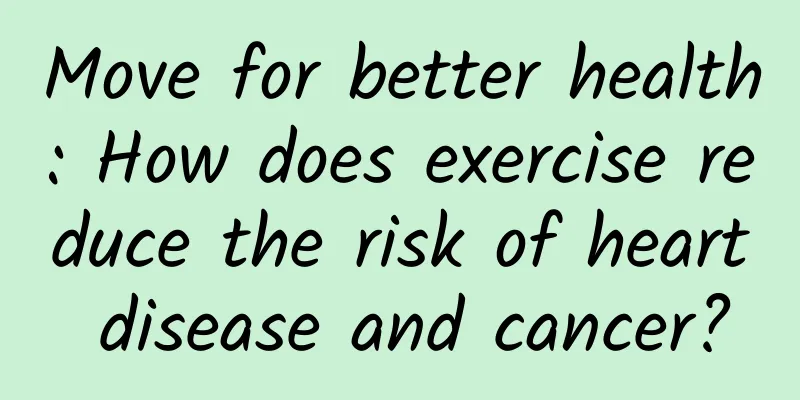Move for better health: How does exercise reduce the risk of heart disease and cancer?

|
Did you know that daily exercise not only helps you stay in shape, but can also significantly reduce your risk of cardiovascular disease, diabetes, and certain cancers? Let's explore how exercise can improve your overall health by improving heart health, enhancing metabolic function, and reducing your risk of cancer. Exercise and heart health Studies have shown that increasing physical activity can significantly reduce the risk of heart disease. A comprehensive analysis of 33 prospective cohort studies found that increasing exercise (from no exercise to 150 minutes of moderate-intensity exercise per week) can effectively reduce the incidence and mortality of cardiovascular disease. One study showed that by increasing exercise, the incidence of cardiovascular disease among participants decreased by 17% and the mortality rate decreased by 23%. More specifically, increasing exercise can not only prevent cardiovascular disease, but for patients who already have coronary atherosclerotic heart disease, if they can remain active for a long time, the risk of cardiovascular death can be reduced by about 50% compared to sedentary people. Why exercise reduces heart disease risk It can reduce the burden on the heart by enhancing heart function, lowering blood pressure, improving blood lipid levels, controlling weight, etc. In addition, exercise can also improve blood sugar control and insulin sensitivity, which are essential for cardiovascular health. Exercise and cancer risk In addition to being good for heart health, exercise can also help prevent many types of cancer. A large study involving 1.44 million participants found that those who maintained a high level of exercise every day had a 38%, 27% and 16% lower risk of esophageal cancer, lung cancer and kidney cancer, respectively. At the same time, exercise can also reduce cancer mortality, with a 18% reduction in all cancer mortality. Why exercise can reduce cancer risk Exercise helps maintain a healthy weight, reduces inflammation in the body, and regulates hormone levels (such as estrogen), which may be closely related to the development of cancer. In addition, exercise can boost the function of the immune system and help eliminate abnormal cells in the body that may cause cancer. Exercise and diabetes More and more studies have shown that exercise can significantly reduce the risk of type 2 diabetes. People who participate in high-intensity or moderate-intensity exercise have a 30% lower risk of type 2 diabetes than sedentary people. Exercise helps improve insulin sensitivity and helps control blood sugar levels, thereby reducing the occurrence of diabetes. How exercise can improve diabetes risk Exercise can help maintain stable blood sugar levels by increasing muscle glucose uptake and improving the body's response to insulin. Even short periods of high-intensity interval training or walking after a meal can effectively lower post-meal blood sugar levels, which is crucial for preventing diabetes. The dangers of sedentary behavior In contrast to exercise, long periods of sitting are very harmful to health. Sitting for long periods of time, watching TV or being inactive for long periods of time can significantly increase the risk of many diseases. Studies have shown that people who sit for a long time have a significantly increased risk of cardiovascular disease, cancer and diabetes. According to studies, people who sit for a long time every day have an 18% increased risk of death from cardiovascular disease, a 17% increased risk of death from cancer, and a 91% increased risk of developing diabetes. Why prolonged sitting increases disease risk Sitting for a long time can lead to poor blood circulation, slow metabolism, increase inflammation in the body, and induce chronic diseases such as cardiovascular disease, cancer, and diabetes. Therefore, reducing sedentary time and exercising appropriately every day can significantly reduce these health risks. How to start exercising? Experts recommend that adults should engage in at least 150 minutes of moderate-intensity exercise or 75 minutes of high-intensity exercise per week , preferably spread over most days of the week. You can choose activities such as walking, cycling, swimming, and yoga to gradually increase the amount and intensity of exercise. Do not exercise excessively at one time to avoid putting too much burden on your body. Health Tips Get up and move around for 5 to 10 minutes every hour, walk around and stretch your body. Try to increase your walking or cycling time in your daily routine, such as walking to and from get off work. Participating in sports with friends not only increases the fun but also encourages each other. Summarize Exercise is a simple and effective way to improve your health. It can reduce the risk of cardiovascular disease, diabetes and certain cancers, improve metabolic health and enhance immunity. On the contrary, sitting for a long time will greatly increase the risk of disease. Therefore, in order to better protect yourself, it is very important to increase the amount of exercise, reduce sedentary behavior, and maintain a healthy lifestyle. As long as you move, health is at your feet! References 1. Wahid, A., et al., Quantifying the Association Between Physical Activity and Cardiovascular Disease and Diabetes: A Systematic Review and Meta-Analysis. J Am Heart Assoc, 2016. 5 (9). 2. Gonzalez-Jaramillo, N., et al., Systematic Review of Physical Activity Trajectories and Mortality in Patients With Coronary Artery Disease. J Am Coll Cardiol, 2022. 79 (17): p. 1690-1700. 3. Moore, SC, et al., Association of Leisure-Time Physical Activity With Risk of 26 Types of Cancer in 1.44 Million Adults. JAMA Intern Med, 2016. 176 (6): p. 816-25. 4. Friedenreich, CM, et al., Physical Activity and Mortality in Cancer Survivors: A Systematic Review and Meta-Analysis. JNCI Cancer Spectr, 2020. 4 (1): p. pkz080. 5. Aune, D., et al., Physical activity and the risk of type 2 diabetes: a systematic review and dose-response meta-analysis. Eur J Epidemiol, 2015. 30 (7): p. 529-42. 6. Smith, AD, et al., Physical activity and incident type 2 diabetes mellitus: a systematic review and dose-response meta-analysis of prospective cohort studies. Diabetologia, 2016. 59 (12): p. 2527-2545. 7. Biswas, A., et al., Sedentary time and its association with risk for disease incidence, mortality, and hospitalization in adults: a systematic review and meta-analysis. Ann Intern Med, 2015. 162 (2): p. 123-32. Author: Li Weiqin, deputy chief physician, Tianjin Women and Children's Health Center |
<<: CICC talks about bacteria丨Lactobacillus acidophilus
>>: Don’t panic when monkeypox comes. Only by knowing “pox” can you fight “pox”!
Recommend
What to do if pregnant women have abdominal pain
Everyone knows that during pregnancy, as the baby...
What is the reason for frequent sneezing and runny nose?
Sneezing is a normal phenomenon in daily life. Sn...
How much does it cost to do B-ultrasound during pregnancy
How much does it cost to do an ultrasound to chec...
My aunt is still bleeding after seven days of menstruation
Everyone has a different reaction to menstruation...
What are the beauty and health teas for women
Women's physiological characteristics are rel...
Don't take menstrual back pain and abdominal pain lightly. Beware of these gynecological diseases.
Because of their special physiological periods, i...
What to eat when pregnant women have swollen and painful gums
Swollen and painful gums are an oral problem that...
What is the story of the squid strips that I discovered by chance? The actor of the squid strips that I discovered by chance
Does Squid look familiar in "A Day Found by ...
Can uterine prolapse recover?
Women will encounter various unexpected problems ...
Will milk knots disappear after weaning?
Now many mothers are in the breastfeeding stage. ...
The necessity of pneumococcal vaccination, these groups of people must understand
In order to enhance the ability to resist externa...
How much does it cost for pregnant women to check their sugar levels?
Sugar screening is a test that expectant mothers ...
How long does it take to get your period after an abortion?
Abortion is something that no one wants to see. I...
Ericsson: Mobile research report, June 2023
Despite geopolitical challenges and macroeconomic...
Don't drink too much of the delicious wine
"No wine, no fun." Alcoholic beverages ...









